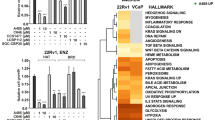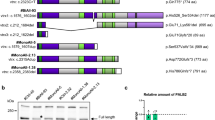Abstract
Normal genital skin fibroblasts (GSF) and the human prostate carcinoma cell line LNCaP have been used widely as cell culture models of genital origin to study androgen receptor (AR) signaling. We demonstrate that LNCaP shows a reproducible response to androgens as assessed using cDNA-microarrays representing approximately 32,000 unique human genes, whereas several independent GSF strains are virtually unresponsive. We show that LNCaP cells express markedly higher AR protein levels likely contributing to the observed differences of androgen responsiveness. However, previous data suggested that AR-expression levels alone do not determine androgen responsiveness of human GSF compared to LNCaP. We hypothesized that cell-specific differences in expression levels of AR coregulators might contribute to differences in androgen responsiveness and might be found by comparing LNCaP and GSFs. Using the Canadian McGill-database of AR coregulators (http://www.mcgill.ca/androgendb), we identified 61 AR-coregulator genes represented by 282 transcripts on our microarray platform that was used to measure transcript profiles of LNCaP and GSF cells. Baseline expression levels of 48 AR-coregulator transcripts representing 33 distinct genes showed significant differences between GSF and LNCaP, four of which we confirmed by reverse transcriptase polymerase chain reaction. Compared to LNCaP, GSFs displayed significant upregulation of AR coregulators that can function as repressors of AR-transactivation, such as caveolin 1. Analysis of a recently published comprehensive dataset of 115 microarrays representing 35 different human tissues revealed tissue-specific signatures of AR coregulators that segregated with ontogenetically related groups of tissues (e.g., lymphatic system and genital tissues, brain). Our data demonstrate the existence of cell-line and tissue-specific expression patterns of molecules with documented AR coregulatory functions. Therefore, differential expression patterns of AR coregulators could modify tissue-specificity and diversity of androgen actions in development, physiology, and disease.







Similar content being viewed by others
References
Hiort O, Holterhus PM (2000) The molecular basis of male sexual differentiation. Eur J Endocrinol 142:101–1101
Vanderschueren D, Vandenput L, Boonen S, Lindberg MK, Bouillon R, Ohlsson C (2004) Androgens and bone. Endocr Rev 25:389–425
Claustres M, Sultan C (1988) Androgen and erythropoiesis: evidence for an androgen receptor in erythroblasts from human bone marrow cultures. Horm Res 29:17–22
Cohen C, Lawson D, DeRose PB (1998) Sex and androgenic steroid receptor expression in hepatic adenomas. Hum Pathol 29:1428–1432
Dorner G, Gotz F, Rohde W, Plagemann A, Lindner R, Peters H Ghanaati Z (2001) Genetic and epigenetic effects on sexual brain organization mediated by sex hormones. Neuro Endocrinol Lett 22:403–409
Meyer-Bahlburg HF, Dolezal C, Baker SW, Carlson AD, Obeid JS, New MI (2004) Prenatal androgenization affects gender-related behavior but not gender identity in 5–12-year-old girls with congenital adrenal hyperplasia. Arch Sex Behav 33:97–104
Andriole G, Bruchovsky N, Chung LW, Matsumoto AM, Rittmaster R, Roehrborn C, Russell D, Tindall D (2004) Dihydrotestosterone and the prostate: the scientific rationale for 5alpha-reductase inhibitors in the treatment of benign prostatic hyperplasia. J Urol 172:1399–1403
Culig Z, Klocker H, Bartsch G, Steiner H, Hobisch A (2003) Androgen receptors in prostate cancer. J Urol 170:1363–1369
Fuller PJ (1991) The steroid receptor superfamily: mechanisms of diversity. FASEB J 5:3092–3099
Jenster G, van der Korput HA, van Vroonhoven C, van der Kwast TH, Trapman J, Brinkmann AO (1991) Domains of the human androgen receptor involved in steroid binding, transcriptional activation, and subcellular localization. Mol Endocrinol 5:1396–1404
Laudet V, Gronemeyer H (2002) The Nuclear Receptor FactsBook. First edition. Academic, London, UK
Shaffer PL, Jivan A, Dollins DE, Claessens F, Gewirth DT (2004) Structural basis of androgen receptor binding to selective androgen response elements. Proc Natl Acad Sci USA 101:4758–4763
Heinlein CA, Chang C (2002) Androgen receptor (AR) coregulators: an overview. Endocr Rev 23:175–200
Hong H, Kohli K, Garabedian MJ, Stallcup MR (1997) GRIP1, a transcriptional coactivator for the AF-2 transactivation domain of steroid, thyroid, retinoid, and vitamin D receptors. Mol Cell Biol 17:2735–2744
Linja MJ, Porkka KP, Kang Z, Savinainen KJ, Janne OA, Tammela TL, Vessella RL, Palvimo JJ, Visakorpi T (2004) Expression of androgen receptor coregulators in prostate cancer. Clin Cancer Res 10:1032–1040
Truss M, Beato M (1993) Steroid hormone receptors: interaction with deoxyri-bonucleic acid and transcription factors. Endocr Rev 14:459–479
McEwan IJ (2004) Essays in biochemistry, the nuclear receptor family. In: Kumar R, Johnson BH, Thompson EB (eds) Overview of the structural basis for transcription regulation by nuclear hormone receptors, 1st edn. Portland Press, London, UK, pp. 27–39
Holterhus PM, Hiort O, Demeter J, Brown PO, Brooks JD (2003) Differential gene-expression patterns in genital fibroblasts of normal males and 46,XY females with androgen insensitivity syndrome: evidence for early programming involving the androgen receptor. Genome Biol 4:R37
Castoria G, Lombardi M, Barone MV, Bilancio A, Di Domenico M, Bottero D, Vitale F, Migliaccio A, Auricchio F (2003) Androgen-stimulated DNA synthesis and cytoskeletal changes in fibroblasts by a nontranscriptional receptor action. J Cell Biol 161:547–556
DePrimo SE, Diehn M, Nelson JB, Reiter RE, Matese J, Fero M, Tibshirani R, Brown PO, Brooks JD (2002) Transcriptional programs activated by exposure of human prostate cancer cells to androgen. Genome Biol 3:R32
McPhaul MJ, Deslypere JP, Allman DR, Gerard RD (1993) The adenovirus-mediated delivery of a reporter gene permits the assessment of androgen receptor function in genital skin fibroblast cultures. Stimulation of Gs and inhibition of G(o). J Biol Chem 268:26063–26066
McPhaul MJ, Schweikert HU, Allman DR, McPhaul MJ, Schweikert HU, Allman DR (1997) Assessment of androgen receptor function in genital skin fibroblasts using a recombinant adenovirus to deliver an androgen-responsive reporter gene. J Clin Endocrinol Metab 82:1944–1948
Holterhus PM, Salzburg J, Werner R, Hiort O (2005) Transactivation properties of wild-type and mutant androgen receptors in transiently transfected primary human fibroblasts. Horm Res 63:152–158
Gottlieb B, Beitel LK, Wu JH, Trifiro M (2004) The androgen receptor gene mutations database (ARDB): 2004 update. Hum Mutat 23:527–533
Shyamsundar R, Kim YH, Higgins JP, Montgomery K, Jorden M, Sethuraman A, van de Rijn M, Botstein D, Brown PO, Pollack JR (2005) A DNA microarray survey of gene expression in normal human tissues. Genome Biol 6:R22
Diehn M, Sherlock G, Binkley G, Jin H, Matese JC, Hernandez-Boussard T, Rees CA, Cherry JM, Botstein D, Brown PO, Alizadeh AA (2003) SOURCE: a unified genomic resource of functional annotations, ontologies, and gene expression data. Nucleic Acids Res 31:219–223
Gollub J, Ball CA, Binkley G, Demeter J, Finkelstein DB, Hebert JM, Hernandez-Boussard T, Jin H, Kaloper M, Matese JC, Schroeder M, Brown PO, Botstein D, Sherlock G (2003) The Stanford Microarray Database: data access and quality assessment tools. Nucleic Acids Res 31:94–96
Eisen MB, Spellman PT, Brown PO, Botstein D (1998) Cluster analysis and display of genome-wide expression patterns. Proc Natl Acad Sci USA 95:14863–14868
Tusher VG, Tibshirani R, Chu G (2001) Significance analysis of microarrays applied to the ionizing radiation response. Proc Natl Acad Sci USA 98:5116–5121
Livak KJ, Schmittgen TD (2001) Analysis of relative gene expression data using real-time quantitative PCR and the 2(-delta delta C(T)) method. Methods 25:402–408
Cleutjens CB, Steketee K, van Eekelen CC, van der Korput JA, Brinkmann AO, Trapman J (1997) Both androgen receptor and glucocorticoid receptor are able to induce prostate-specific antigen expression, but differ in their growth-stimulating properties of LNCaP cells. Endocrinology 138:5293–5300
Rubin MA, Varambally S, Beroukhim R, Tomlins SA, Rhodes DR, Paris PL, Hofer MD, Storz-Schweizer M, Kuefer R, Fletcher JA, Hsi BL, Byrne JA, Pienta KJ, Collins C, Sellers WR, Chinnaiyan AM (2004) Overexpression, amplification, and androgen regulation of TPD52 in prostate cancer. Cancer Res 64:3814–3822
Segawa T, Nau ME, Xu LL, Chilukuri RN, Makarem M, Zhang W, Petrovics G, Sesterhenn IA, McLeod DG, Moul JW, Vahey M, Srivastava S (2002) Androgen-induced expression of endoplasmic reticulum (ER) stress response genes in prostate cancer cells. Oncogene 21:8749–8758
Dhanasekaran SM, Dash A, Yu J, Maine IP, Laxman B, Tomlins SA, Creighton CJ, Menon A, Rubin MA, Chinnaiyan AM (2005) Molecular profiling of human prostate tissues: insights into gene expression patterns of prostate development during puberty. FASEB J 19:243–245
Qi H, Labrie Y, Grenier J, Fournier A, Fillion C, Labrie C (2001) Androgens induce expression of SPAK, a STE20/SPS1-related kinase, in LNCaP human prostate cancer cells. Mol Cell Endocrinol 182:181–192
Xu LL, Shanmugam N, Segawa T, Sesterhenn IA, McLeod DG, Moul JW, Srivastava S (2000) A novel androgen-regulated gene, PMEPA1, located on chromosome 20q13 exhibits high level expression in prostate. Genomics 66:257–263
Nasu Y, Timme TL, Yang G, Bangma CH, Li L, Ren C, Park SH, DeLeon M, Wang J, Thompson TC (1998) Suppression of caveolin expression induces androgen sensitivity in metastatic androgen-insensitive mouse prostate cancer cells. Nat Med 4:1062–1064
Lin HK, Yeh S, Kang HY, Chang C (2001) Akt suppresses androgen-induced apoptosis by phosphorylating and inhibiting androgen receptor. Proc Natl Acad Sci USA 98:7200–7205
Hayes SA, Zarnegar M, Sharma M, Yang F, Peehl DM, ten Dijke P, Sun Z (2001) SMAD3 represses androgen receptor-mediated transcription. Cancer Res 61:2112–2118
Schneikert J, Peterziel H, Defossez PA, Klocker H, Launoit Y, Cato AC (1996) Androgen receptor-Ets protein interaction is a novel mechanism for steroid hormone-mediated down-modulation of matrix metalloproteinase expression. J Biol Chem 271:23907–23913
Petre CE, Wetherill YB, Danielsen M, Knudsen KE (2002) Cyclin D1: mechanism and consequence of androgen receptor co-repressor activity. J Biol Chem 277:2207–2215
Chen S, Wang J, Yu G, Liu W, Pearce D (1997) Androgen and glucocorticoid receptor heterodimer formation. A possible mechanism for mutual inhibition of transcriptional activity. J Biol Chem 272:14087–14092
Panet-Raymond V, Gottlieb B, Beitel LK, Pinsky L, Trifiro MA (2000) Interactions between androgen and estrogen receptors and the effects on their transactivational properties. Mol Cell Endocrinol 167:139–150
Wang M, Wang J, Zhang Z, Zhao Z, Zhang R, Hu X, Tan T, Luo S, Luo Z (2005) Dissecting phenotypic variation among AIS patients. Biochem Biophys Res Commun 335:335–342
Alen P, Claessens F, Verhoeven G, Rombauts W, Peeters B (1999) The androgen receptor amino-terminal domain plays a key role in p160 coactivator-stimulated gene transcription. Mol Cell Biol 19:6085–6097
Pratt WB (1992) Control of steroid receptor function and cytoplasmic-nuclear transport by heat shock proteins. Bioessays 14:841–848
Lu ML, Schneider MC, Zheng Y, Zhang X, Richie JP (2001) Caveolin-1 interacts with androgen receptor. A positive modulator of androgen receptor mediated transactivation. J Biol Chem 276:13442–13451
Cho KA, Ryu SJ, Park JS, Jang IS, Ahn JS, Kim KT, Park SC (2003) Senescent phenotype can be reversed by reduction of caveolin status. J Biol Chem 278:27789–27795
Izbicka E, MacDonald JR, Davidson K, Lawrence RA, Gomez L, Von Hoff DD (1999) 5,6 Dihydro-5′-azacytidine (DHAC) restores androgen responsiveness in androgen-insensitive prostate cancer cells. Anticancer Res 19:1285–1291
Metzger E, Wissmann M, Yin N, Müller JM, Schneider R, Peters AHFM, Günther T, Buettmer R, Schüle R (2005) LSD1 demethylates repressive histone marks to promote androgen-receptor-dependent transcription. Nature 437:436–439
O’Malley B (2005) The biological and medical implications of steroid receptor coactivators. Presidential Plenary Session. Annual Meeting of the Endocrine Society, San Diego, CA, USA
Adachi M, Takayanagi R, Tomura A, Imasaki K, Kato S, Goto K, Yanase T, Ikuyama S, Nawata H (2000) Androgen-insensitivity syndrome as a possible coactivator disease. N Engl J Med 343:856–862
Deeb A, Mason C, Lee YS, Hughes IA (2005) Correlation between genotype, phenotype and sex of rearing in 111 patients with partial androgen insensitivity syndrome. Clin Endocrinol 63:56–62
Acknowledgements
The study was supported by the Deutsche Forschungsgemeinschaft (DFG) (grants Ho 2073/2-1, 2-2 and KFO 111/1-1, and 1-2, projects C and D to P.M.H.) with support by the Medical Faculty of Lübeck of the University of Schleswig-Holstein, Germany (P.M.H and O.H.), and the Doris Duke Charitable Foundation (J.D.B.). We thank Genevieve Vidanes, Nicole Homburg, Christine Marschke, Erika Meinecke, and Dagmar Struve for excellent technical assistance. We also thank the scientists and staff of the Stanford Microarray Facility and the Stanford Microarray Database.
Author information
Authors and Affiliations
Corresponding author
Rights and permissions
About this article
Cite this article
Bebermeier, JH., Brooks, J.D., DePrimo, S.E. et al. Cell-line and tissue-specific signatures of androgen receptor-coregulator transcription. J Mol Med 84, 919–931 (2006). https://doi.org/10.1007/s00109-006-0081-1
Received:
Accepted:
Published:
Issue Date:
DOI: https://doi.org/10.1007/s00109-006-0081-1




